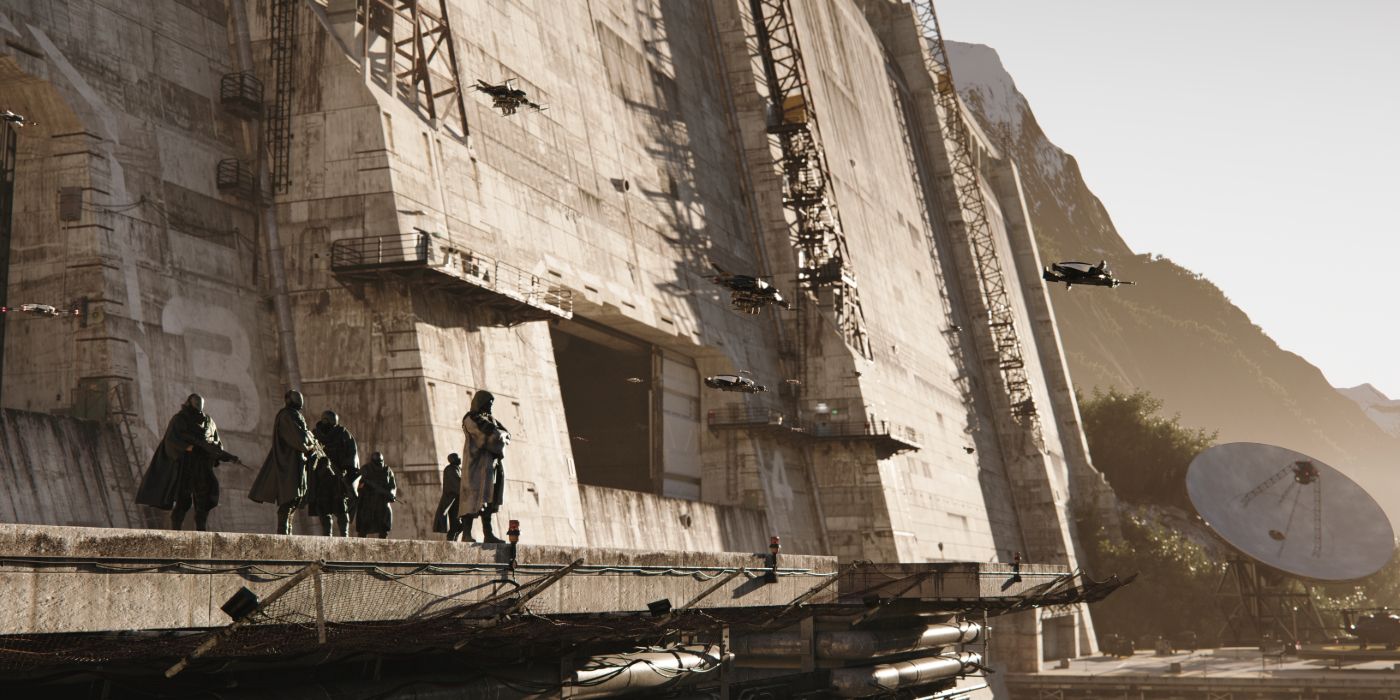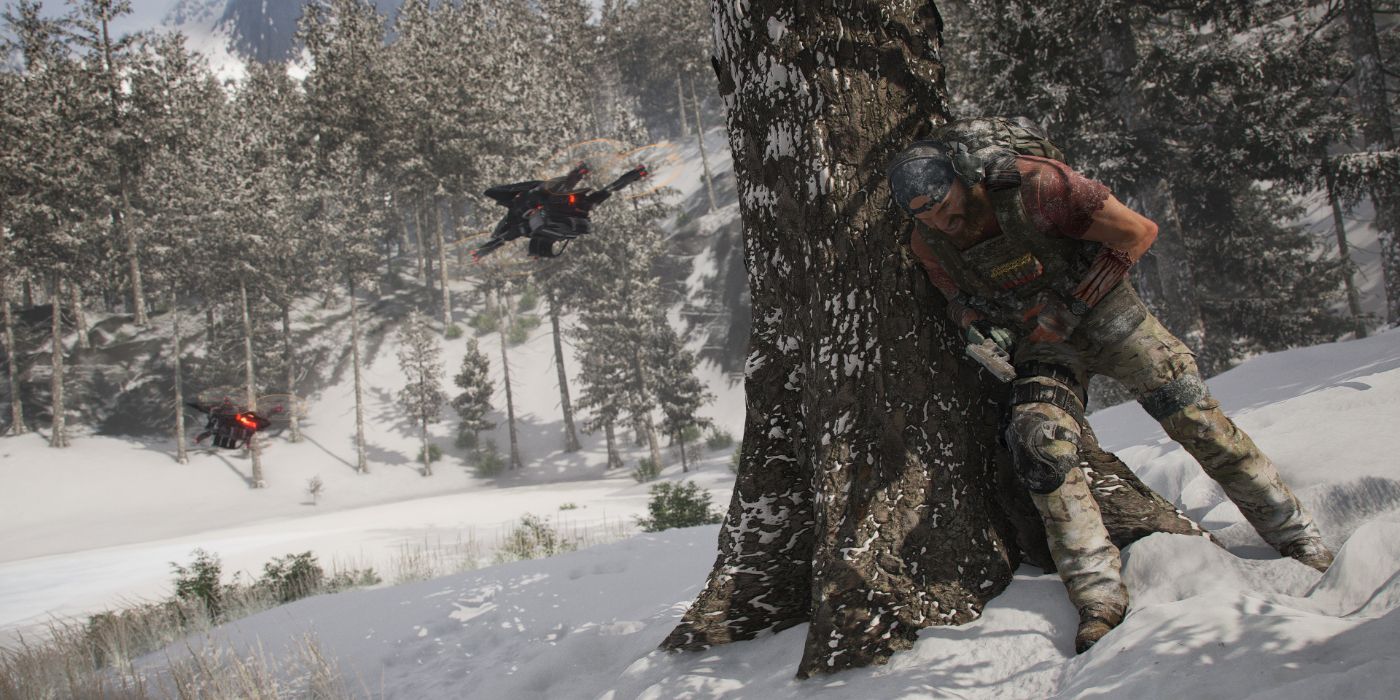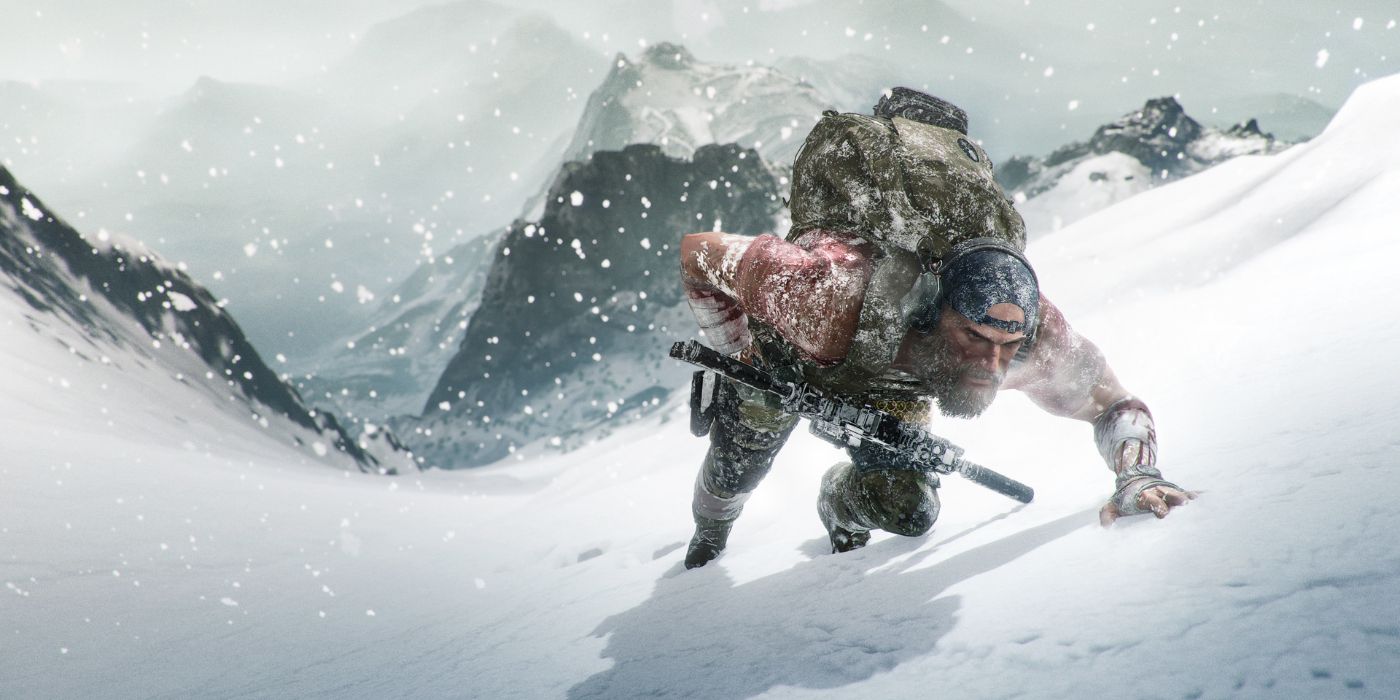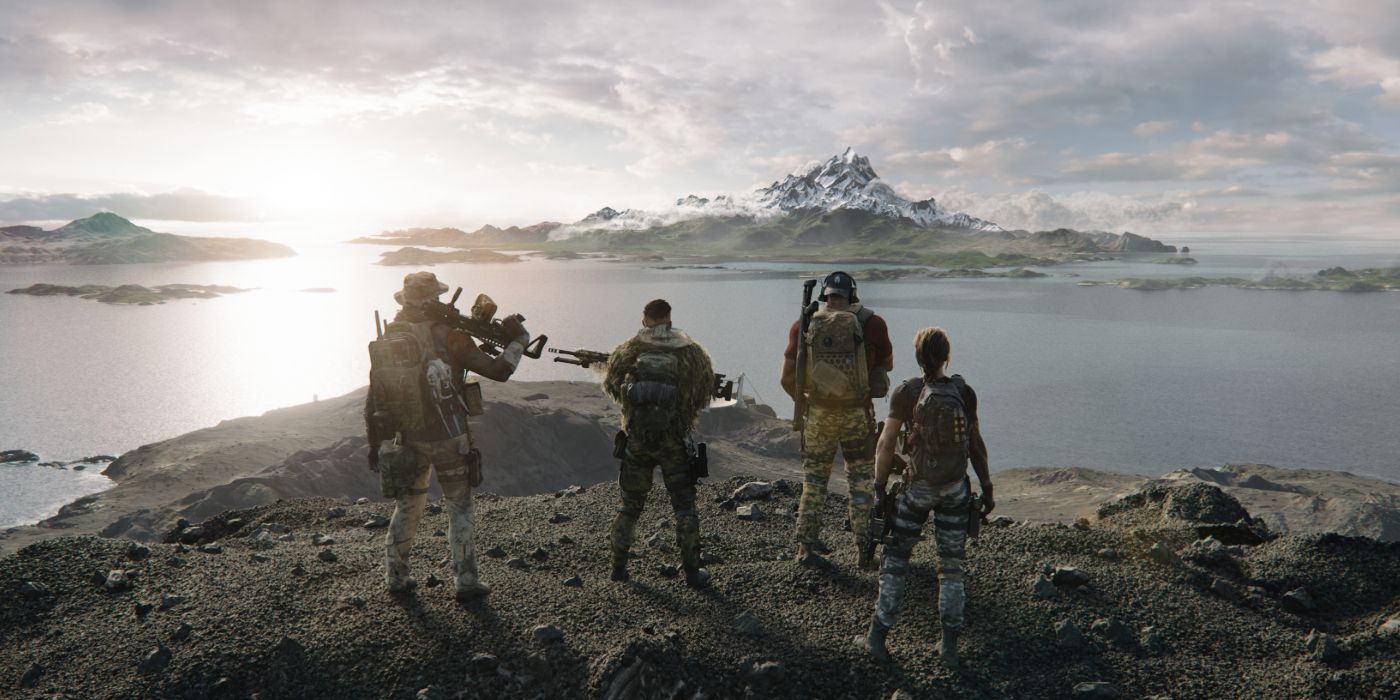Ghost Recon: Breakpoint pushes the series further than it's ever gone before. From a gameplay standpoint, that means the inclusion of several features that have never existed within Ghost Recon before, each meant to test player's ability to think and assess situations with as little information as possible. When the game was unveiled during a hands-on preview event in New York last week, it was clear that Breakpoint intends to take everything that made Ghost Recon: Wildlands palatable while infusing it with all the lessons learned by Ubisoft during that game's lengthy life cycle.
If Breakpoint succeeds, it will be in part due to Matthew Tomkinson, the User Experience & Realization Director for Ghost Recon: Breakpoint. He's in charge of getting players up to speed on all the changes to the formula that Breakpoint is proposing, and he's also part of the reason that the games now feel so much more like an unfurling, living narrative rather than a cordoned-off one-shot. During the hands-on preview event, Screen Rant was able to sit down with Tomkinson and discuss how much bigger Breakpoint is when compared to the size of Ghost Recon: Wildlands, some of the hidden treasures that will be scattered across the world for fans to find, and the developer's already existing plans to expand the game post-launch with a new island. Check it out after the jump.
So first of all, just introduce yourself, tell us what you do on Ghost Recon: Breakpoint.
Matthew Tomkinson: My name is Matthew Tomkinson, I’m User Experience & Realization Director on the game. It means that I’m in charge of all the understanding, the learning, the beginning of the game - I’m in charge of this part as the User Experience Director, and I’m also in charge of the different menus so I know quite well all the elements of the game because you have to understand them. In terms of realization I’m also in charge of the cinematics, all the cinematic feeling of the game.
We got to look at what I think is close to almost everything when it comes to new features being shown off in the game. How are you going to onboard new users with all these new functions? How do you make that a smooth, streamlined experience?
MT: We have an approach on Ghost Recon that the freedom that the game offers is something that we want to propose quite early. So you saw the beginning of the game here and it will be quite similar - we want the players to have a very minimal element of context before they really start playing, and they will start playing very early. And they will discover all the elements of the context of the island with lots of questions first. We want to make sure that the player has questions, they want to learn more about the game, before we really answer that. And they will discover it at the same rhythm as their character. So really the idea is that there is this world, the future of the world that Jay Skell is trying to invent in the Pacific Ocean, and there’s a blackout - the communication has stopped. And the Ghosts are sent there but then they crash as you saw in the demo, and no more information - it’s like the beginning of the game is almost wordless. They crash and then you have to discover everything by yourself. And what we do is that we introduce the player to a mode where they can go anywhere as soon as the game starts. It’s not like you have a scripted experience. And then by discovery we make sure that we bring the different elements for the player to discover. At some point you will understand the use of the bivouac, all the different preparations.
How do you start a player off with that level of difficulty and still make it accessible? What were the challenges in designing that?
MT: Well, I understand your comment knowing that maybe starting without giving too much information could be like you lack information. But you also feel that sometimes in games you start with too much information where you don’t need it. When you start with cinematics where you give lots of elements of context, sometimes you just want to start and play. And then the questions appear. So it’s a matter of good balance, you make sure that the players don’t face too many enemies at the beginning and that he can practice himself, that he can choose when he wants to go there rather than have it coming at you, it can be you that is led to go towards the enemies and to discover the items one by one, discover their use progressively, and I think that’s the good way to approach it. Especially if you want an experience where we don’t hold your hand too much. I think it’s something that is specific to our players - they very often like to feel like they’re in charge rather than being told what to do.
Yeah. You mention in the presentation that this was the game that players asked for.
MT: Yeah.
So tell us what that means - what were people asking for that you feel you’ve brought to this game?
MT: When we were developing Wildlands we were a bit in the dark because we had the Ghost Recon brand that was quite strong but was never an open world game. Never about this level of freedom. And since we released it, we’ve had the opportunity to release 19 total updates with the one that’s released today. So we got lots of feedback - positive feedback, and sometimes negative feedback - and we were able to tweak it accordingly. And here we feel it’s like we are in the light compared to before. We know that the players want a quite demanding experience. It can be in terms of difficulty and also in terms of freedom. They want - for example, in my field - they want to be able to remove the UI. To detect where the enemies are by themselves. Without having, by default, the red spots on the minimap. It’s things we’ve taken in mind as soon as we start imagining the game, and we take into consideration and make sure that the game can support those elements. Being reactive about it is not always easy, but when you know it quite early when you start the game, it makes things much easier.
19 updates for Wildlands. Are you planning on diving that deep into this new title as well?
MT: Oh yeah. It's really a game that we imagine being played for years to come. We have lots of ideas. We have already prepared quite strong content for endgame players, like the raids that will be released quite early after [launch]. There’s so much more - I won’t go too much into detail today because we are more here to talk about the game that will be out day one, but there will be lots of content for the game and the players. We wanted to make it like a place where you live, where you spend time, where you grow with your character with lots of new stuff to discover.
When we’re doing freeplay when you jump right into the game - will there be areas sectioned off that are too difficult? Will you be able to tackle what you want to tackle right from the start?
MT: There are parts in the game that might be too difficult for you when you start with the biggest reward. But most of the game - even if you have played for 120 hours, and you have a friend that is new to the game, it’s something [playing together] that’s still totally possible. And with a few exceptions of places that are super high level, most of the game can be played with players who are just starting. So it’s really up to you. And we don’t want to split the community of players. That’s really one thing we had in mind since the beginning.
If you just brute force try to push through the game - what are we looking at in terms of hours played?
MT: We don’t really reason like that. I’m not talking about the end, but there won’t be rolling end credits in the game. There is a storyline with a sense of closure at some point, but it will still be open, and after that there will be more content to continue the story after the release of the game. There’s lots of objectives that you can set for yourself. There are what we call faction missions, where you can help different factions that are renewed every day in the game. There are more characters to discover that are hidden everywhere in the world. And it’s not like missions that are put in your face - it’s up to you to discover and do this content. Also, all the weapons, all the items, all the crafting systems - we’ve developed a system where you can pin them where they will appear in your interface exactly like if it was a story mission. So we are supporting the players that don’t even want to be told the story, that want to live their own story, and if they want this weapon or this attachment or they want this to unlock - they can pin it and go for it as if it was a mission. So there is so much stuff to do that we cannot really reason in terms of hours being - it’s almost infinite.
So do you think this is a game that someone could enjoy if they just completely ignored the story?
MT: Oh, yeah, yeah! Absolutely! It’s like - we have people in the team that are more focused on story and myself, I worked quite a lot on it, but I totally understand the players that want to just dive in the game and just hang around with friends. To me, you have two hours with friends and you just want to mess around, you want to take vehicles, you want to go to a place, you want to attack this place and get rewards - we are totally supporting it. I think the game will be different in this way, but still very enjoyable.
How big an impact does the new features about survival have on the storytelling and how you kind of pace the game? Will survival be a major factor in basically all of the gameplay?
MT: Globally it’s a matter that we discuss a lot in the creative team. It’s more in terms of mood. There’s a slow pace that’s present in the game where you take time, you explore your environment. It’s not like we always push to your face everything that can be done in the game - it’s up to you to discover it also. There’s the preparation before battle. All the recon phase is really important - there are other games that are more about action, action, action, all the time. Here you have all this preparation, all this survival, and then when you attack, it can be super intense. I think this question of contrast makes it even more meaningful when you go in, very fast-paced action, because there’s been this time that is more calm just before that. The calm before the storm.
The rhythm of the game.
MT: Yeah.
With the open world and these survival mechanics, and everything that’s happening - how viable is it to just kind of sit down with a bunch of your friends and just all tackle your own stuff and meet up later?
MT: It was already the case in Wildlands and a thing that we love and that’s really not easy to do at first, design-wise, and technology-wise - but here you can do whatever you want. You can play. And someplace in the world, you can do two different missions no problem. If you want to meet up at some point, it’s really up to you. There’s no leash at all between the two players. They don’t have a minimum distance, you can really do what you want. And it feels like if you want to hang around and just discuss, it’s okay, at some point you will see your friend over there [and say] “okay I’ll join you in the mission.”
How big is the world we’re talking about here?
MT: It’s big. It’s very big. I would say it’s...the main island is very similar to the size of Bolivia we had created for Wildlands. Which is really huge. Even myself, there are places that after playing long hours I discovered. I haven’t told it to anyone but there are places called the Wild Mysteries that are unique - we have procedural technology to build our world, but there is so much stuff that we’ve done by hand. Plenty of different secrets to discover. It means that it will not only be very big, but it will be very dense and packed with plenty of elements, of rewards to find, secrets to unveil, collectibles to get while you learn more about the story of the island. That being said, since it’s on an archipelago, we also allowed ourselves to develop new islands and develop new elements that the players might do. So for example, the red island is a huge volcano and you can see it from afar - you can see it starting to be active, and it teases you, and then after you can go there and still discover very different environments and the red island is so different. We really went far on this one.
Would you say this is the furthest you’ve pushed Ghost Recon design?
MT: Well, oh yeah, for sure. For sure. We’ve been very bold with it. Even in Ubisoft, you know we all work on different games. And when the other teams saw what we’ve done, they said “yeah, okay, are you sure you want to do that much content?” Talking about the environment, we still want it to feel realistic and stay authentic, but still we wanted a volcano. We wanted all the base around it and it will be super exciting for the players.
With the archipelago setting, are you planning to add new islands as the game progresses?
MT: Yeah. I don’t know if we are supposed to talk about it, but yes, we are already planning a new island. No no, but I am saying that and you’ll understand when you open your map that we tease about very big new content here. Already it will be huge at the start, but yeah, there will much more to come.




